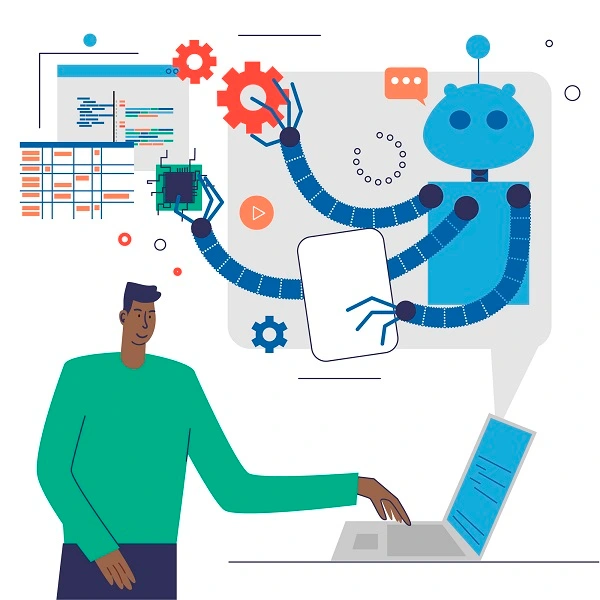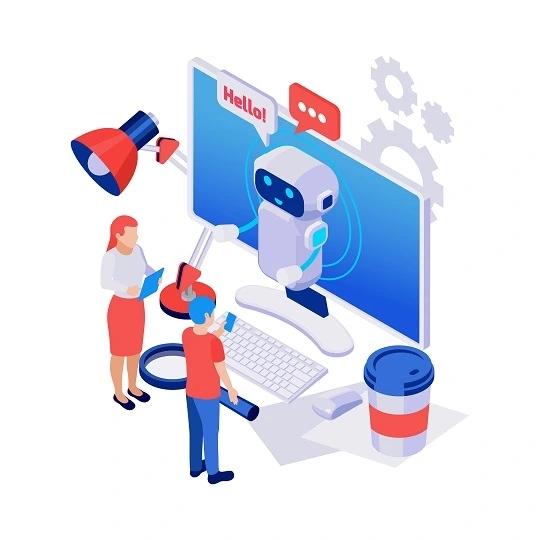GPT – The Rise of Artificial Intelligence in Science

Artificial Intelligence (AI) is a rapidly evolving branch of computer science. AI refers to the ability of machines to perform tasks that require human intelligence, such as learning, reasoning, and perception. AI systems can detect patterns in data, recognize objects, make decisions and understand natural language. They can also solve complex problems and provide solutions quickly and accurately.
Amongst the different types of tasks that AI algorithms are trained to perform, content generation has so far produced the greatest amount of discussion. And this all started with the introduction of the GPT.
What is GPT?
GPT stands for Generative Pre-trained Transformer. It is an advanced language processing system capable of analyzing large amounts of natural language data. The algorithm uses a neural network with billions of parameters and deep learning methods. It can understand and comprehend questions and commands given by humans and generate the relevant output accordingly.
The technology has been developed by OpenAI, a research laboratory based in San Francisco. Its performance has improved significantly since its first introduction in 2018, making it one of the most promising artificial intelligence technologies today.
GPT algorithm in science
Artificial intelligence has entered various industries as well as the scientific world. It is widely used to create models and simulations in different fields. Its rapid development is causing concern for some researchers. Advocates underline the fact that AI is capable of working through large amounts of data faster and more efficiently. It can also help us learn about complex and nuanced topics, allowing for a deeper understanding that may have seemed impossible before.
The opponents point out the potential bias in the generated results and ethical implications. They are also anxious about the fact that this new technology is largely funded and driven by private companies, and that they are leaping ahead of academia uncontrolled.
Applications of GPT
GPT gained worldwide attention with the release of the GPT-3 version in 2020. GPT-3 has a profound ability to generate new, coherent sentences and engaging content using its own logic:
- Automatic replies to emails and messages
- Texts for websites, blogs and newsletters
- Article summaries
- Songwriting and screenwriting ideas
- Human-like replies on chatbots.

GPT-3 can produce content that would normally take hours or even days to craft. It has become a major time saver for many professionals that need to get their message out quickly and effectively.
Can I use AI to write my thesis?
In June 2020 Almira Osmanovic Thunström, a Swedish researcher, tried the possibility of creating a whole academic paper with the use of AI technology. She asked GPT-3 to „Write an academic thesis in 500 words about GPT-3 and add scientific references and citations inside the text„.
Thunström was astonished to see the algorithm producing „novel content written in academic language, with references cited in the right places and in relation to the right context“ that „looked like any other introduction to a fairly good scientific publication„, and all in a matter of minutes.

The researcher described her experience with the GPT language model at scientificamerican.com. The AI-generated paper, called Can GPT-3 write an academic paper on itself, with minimal human input?, is available in an open access modelat the preprint server Hal Open Science.
ChatGPT – how to talk with a computer?
In November 2022 OpenAI announced its newest product called ChatGPT. ChatGPT is a web app, designed for chatbot applications and powered by GPT technology. Its main purpose is to conduct conversations with humans in natural language.
Chatbots are programs that provide services such as: answering customer queries, assisting with online purchases, scheduling appointments, or providing entertainment. ChatGPT is so far the most powerful application of that kind. It allows users to request or ask anything, understanding the query and responding accordingly.

ChatGPT has transformed the way humans interact with machines. Its dialogue-based approach is easy to use and does not require expert scientific or programming knowledge. As a result, it has been quickly picked up and utilized for a variety of applications including:
- suggestions for fiction, non-fiction, poetry, and more
- creative writing, including short stories, screenplays, blog posts
- text translation between different languages
- generation of summaries and explanations of complex concepts and ideas
- production of educational materials including study guides, quizzes, and flashcards.

ChatGPT has been also picked out by students as an essay-writing tool. The Internet swells with tutorials, both in written and video forms, that provide guidance on how to use the algorithm to generate essays and do homework.
The Guardian writes about a student assignment completed by AI technology. Prof. Dan Gillmor from Arizona State University, admits that such an assignment would have received a good grade, adding that “academia has some very serious issues to confront.”
GPT as a source of ideas or a threat to academic integrity?
The possibility to generate scholarly papers in a fast and effortless way initiated heated discussions in the academic world. Universities around the globe raised concerns regarding dissertations and theses created with the use of AI. Most of them oppose such practices and treat AI-generated works as plagiarism, arguing that content generated by a machine cannot be accepted as a researcher’s original piece.
Disputes about whether AI can be called an author also continue. Thunström had started to ask these questions already back in 2020 in her blog piece on scientificamerican.com: if a researcher uses GTP to write an academic paper to whom does the paper’s authorship belong? Is it correct to designate GTP as a co-author? What about copyright and any possible conflict of interest?
The next issue discussed by scholars was the novel aspect of the created work. GPT is not able to generate new knowledge and new concepts. The technology produces texts based on an existing content, rephrasing what already has been said. Original research results are the basis for most scholarly articles. Their lack may be an indication of a problem for the reviewing panel, helping reviewers identify questionable papers. Student homework is not assessed as strictly, so those in education might get away with a copied text much easier.

In the recent paper Can artificial intelligence help for scientific writing? Michele Salvagno, Fabio Silvio Taccone and Alberto Giovanni Gerli have explored further any possible ethical violations. They point out that the GPT algorithm is likely to be used to boost researchers‘ portfolios of published works. The authors warn institutions against hiring professionals solely based on the number of publications, as those may not necessarily prove their expert knowledge. They also discuss the possible widening of the existing gap between low and high-income countries. ChatGPT is currently available free of charge, but it is not guaranteed that fees will not occur in the future.
Scholars around the globe also talk about the possibility of disseminating factual errors that will increase the number of already existing biases and inaccuracies. The Internet is full of beliefs, stereotypes and personal opinions that might be the basis for generated content. The technology lacks the relevant expertise and judgement, and is not capable of assessing the quality of the content it uses to generate new texts.
Positive aspects of language models
AI does not need to be perceived only as a threat. Advocates underline the potential of ChatGPT to become an ally to non-native English speakers. The language model can help them overcome language barriers, and assist in shaping good-quality papers with correct syntax, grammar and punctuation.
The app, despite being originally trained in the English language, is capable of making text corrections, translating documents and producing output in other languages, including Spanish, Chinese, Polish, Korean or German, amongst many others.
How can one determine whether a text was produced by a language model?
GPT-3 and ChatGPT have opened up a world of possibilities for writers and researchers alike. Academia must face the new trends and find a way to preserve academic integrity. Although there is no simple method to verify which texts have been machine-generated, editors and reviewers may look for some indicators of the content origin:
- Text coherence – while algorithms like ChatGPT are capable of producing meaningful content, instances of disjointed or nonsensical phrases may still occur
- Text quality – AI chatbots have a particular writing style. The overall tone and quality might become a signal of whether a text was produced by ChatGPT or by humans
- Text consistency – language models are trained on large datasets and may reproduce patterns from those datasets. Consistent structures or themes appearing throughout the text may indicate that the text was generated with the use of AI.
AI writing checkers
Turnitin, the provider of the SimilarityCheck plagiarism-checking software delivered by Sciendo to its clients, announced at the beginning of April 2023 the launch of an AI writing detector. The detector aims to help educators identify cases where AI writing tools have been used. Turnitin claims to be „able to detect the presence of AI writing with 98% confidence and a less than one per cent false-positive rate“ in a controlled lab environment.
Other AI-detecting tools are also starting to emerge, with GPTZero being one of the examples. However, at the current moment none of this software is capable of delivering a 100% accuracy score.
The future of artificial intelligence in science
AI has been the focus of scholars for years. What has changed, is its global use and the wide range of its possible applications. Editorial boards need to adapt their policies to the existing situation, outlining acceptable research methods and the use of AI systems.
AI algorithms and language models offer a lot of benefits and practical applications. As with any new technology, ethical considerations need to be taken into account and more needs to be done to understand how it could be used safely and effectively.
Further reading
- AI (Artificial Intelligence) Bot GPT-3 Finished a 500-Word Academic Thesis
- GPT-3 Wrote an Entire Paper on Itself. Should Publishers be Concerned?
- Academic minds ‘vital’ as fears grow over ‘out of control’ AI
- Artificial Intelligence Not Yet Intelligent Enough to be a Trusted Research Aid
- ChatGPT vs. GPT-3 and GPT-4: What’s the difference?
- Introducing ChatGPT Plus
- Using ChatGPT to Write Your Thesis the Right Way
- Can Turnitin Detect Chat GPT?
- How generative AI like ChatGPT is pushing assessment reform
How to ensure the originality of your paper and avoid plagiarism
The research process expects ethical behaviour and good practice. As plagiarism and self-plagiarism are on the increase, scientific publishers are using software to detect these instances of scientific misconduct.
read morePress release: Learning Analytics: a Metacognitive Tool to Engage Students
The presented study is the result of the research project ‘Open Online Learning for Digital and Networked Society (3.3-LMT-K-712-01-0189)’, funded by the European Social Fund according to the activity ‘Improvement of researchers’ qualification by implementing world-class R&D projects’ of Measure No. 09.3.3-LMT-K-712 under the grant agreement with the Research Council of Lithuania (LMTLT).
read moreEnglish language editing and copy editing
This is the first in a series of articles on aspects of the production process at Sciendo. This article covers language editing and copy editing services. Language editing and copy editing services help make improvements to an article or book by addressing a wide range of potential issues with language.
read more